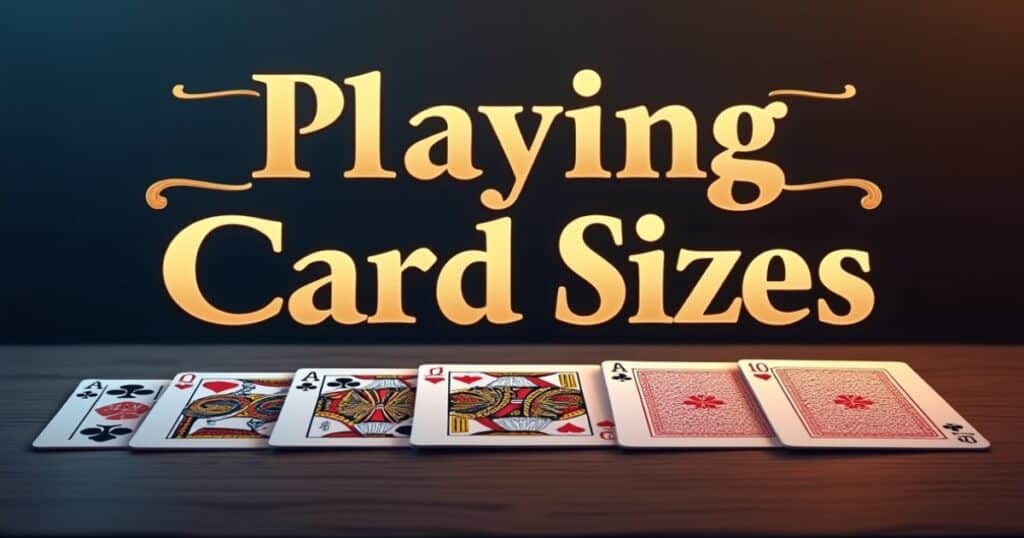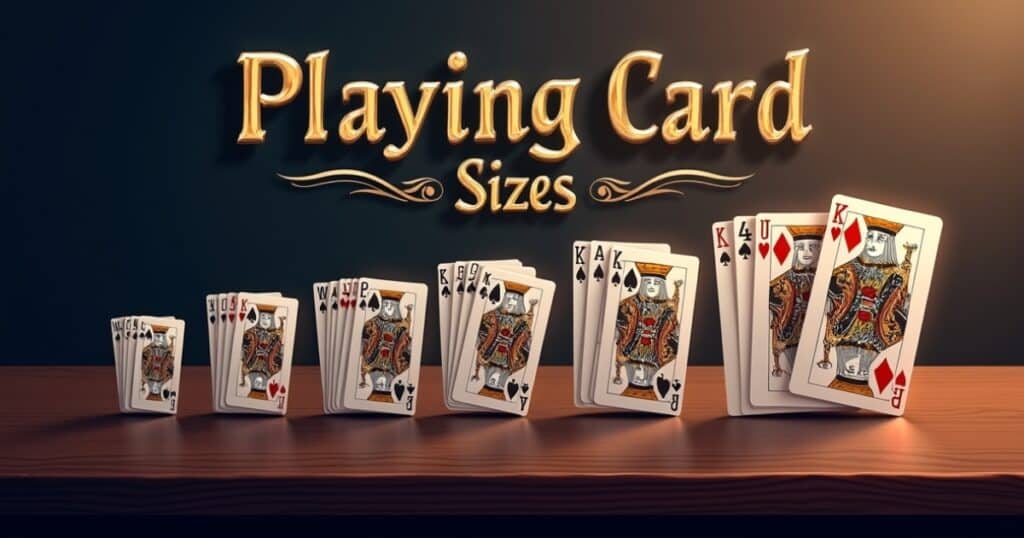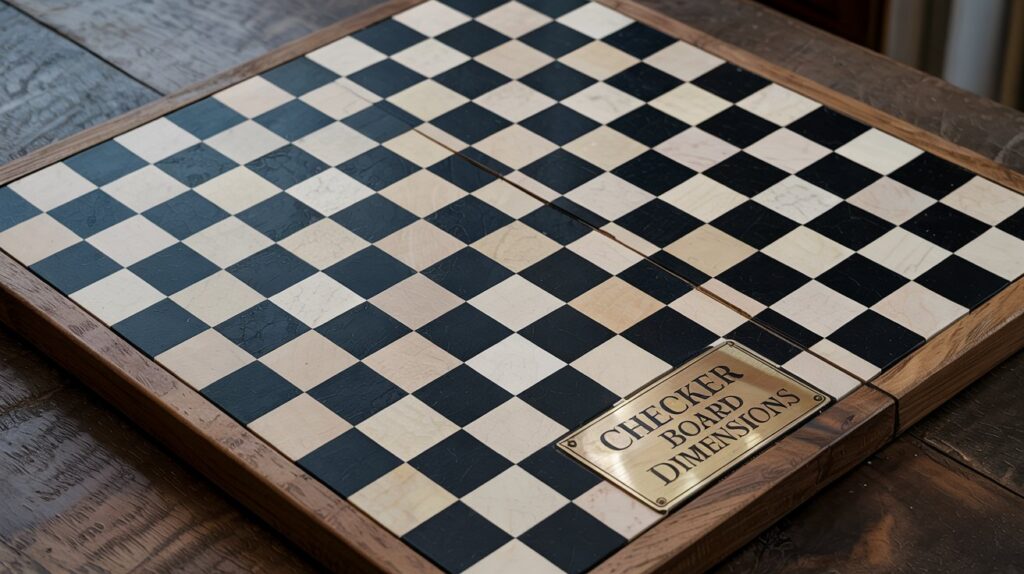Have you ever wondered why playing cards feel just right in your hands? Or why some cards shuffle better than others? The secret lies in their perfectly calibrated dimensions. From poker nights to magic tricks, playing cards have woven themselves into our cultural fabric, and their precise measurements play a crucial role in how we experience card games and performances.
Whether you’re a casual player, professional magician, or curious collector, understanding playing card sizes opens up a fascinating world where tiny variations make enormous differences.
Let’s shuffle through the deck of knowledge about playing card dimensions and discover why these seemingly simple rectangles of cardstock deserve our attention.
How Big Are Standard Playing Cards?
Standard poker-sized playing cards measure 2.5 inches (63.5mm) wide by 3.5 inches (88.9mm) tall. This isn’t random these dimensions create the perfect balance between handling comfort and visibility. You’ll find these proportions everywhere from Las Vegas casinos to your family game night.
They fit comfortably in most hands, allow for easy shuffling, and display their information clearly without overwhelming a tabletop.
Bridge Size vs. Poker Size: The Classic Rivalry
The world of playing cards features two main standard sizes that have competed for popularity for generations:
Poker Size Cards dominate the American market and most casino settings. At 2.5″ × 3.5″ (63.5mm × 88.9mm), they provide ample space for card faces while maintaining excellent handling properties. The extra width compared to bridge cards gives them stability during dealing and allows for easier reading of corner indices.
What makes poker cards so prevalent? Their increased width creates a more stable platform when dealing face-up cards in games like Texas Hold’em. The additional real estate also allows for more elaborate designs and artwork a crucial consideration for modern deck creators and collectors.
I’ve found that poker cards create a satisfying snap when flicked or shuffled, thanks to their larger surface area interacting with the air. This tactile pleasure isn’t insignificant it’s part of what makes handling a quality deck so enjoyable.
Bridge Size Cards run narrower at 2.25″ × 3.5″ (57mm × 88.9mm), maintaining the same height but reducing width by a quarter inch. These slimmer cards developed historically to accommodate the closer hand positioning in the game of bridge, where players typically hold more cards.
Bridge cards excel in situations where hand size matters. People with smaller hands often prefer them, as do those playing games requiring holding numerous cards simultaneously. The reduced width makes fan displays more compact and manageable.
During intense bridge tournaments, players appreciate the reduced strain on their hands when holding 13 cards at once. The narrower profile allows for a more comfortable grip without sacrificing readability.
Mini Cards: Portable Play
When standard cards won’t fit the bill, mini playing cards step in at approximately 1.75″ × 2.5″ (44mm × 63mm). These diminutive decks retain all the functionality of their larger cousins while offering unmatched portability.
Mini cards excel in travel situations fitting easily in jacket pockets, purses, or backpack compartments where standard cards would be cumbersome. They’re popular for camping trips, long flights, and emergency entertainment kits.
Despite their small size, quality mini decks maintain surprising usability. Manufacturers carefully adjust indices and court card designs to ensure readability despite the reduced dimensions. Some even feature specialized backs designed to be more visible when fanned in smaller formats.
I once witnessed a professional magician perform astonishing sleight-of-hand routines with mini cards on a crowded subway train. The compact size allowed for performance in a space where standard cards would have been impossible to manipulate effectively.

Jumbo Cards: When Bigger Is Better
At the opposite end of the spectrum, jumbo cards measure approximately 3.5″ × 5″ (89mm × 127mm) or larger. These oversized decks serve specialized purposes where visibility trumps handling considerations.
Jumbo cards shine in teaching environments, allowing instructors to demonstrate techniques to larger audiences. They’re also invaluable for those with visual impairments who struggle with standard-sized indices and pips.
The entertainment value of jumbo cards can’t be overlooked. They create an immediate visual impact and often serve as conversation pieces. Children delight in handling these “grown-up” items that suddenly feel child-sized in their hands.
Magic performers frequently incorporate jumbo cards as visual punctuation in their routines. A standard card might transform into a jumbo version as the climax of an illusion, creating a moment of wonder through the unexpected scale shift.
Specialized Playing Card Dimensions
Beyond standard sizes, specialized cards serve particular needs with their unique dimensions:
Tarot Cards typically measure 2.75″ × 4.75″ (70mm × 120mm), noticeably taller than standard playing cards. This elongated format accommodates the more detailed artwork essential to tarot symbolism and readings.
The additional height creates space for the elaborate scenes depicted on tarot cards, particularly in the Major Arcana. This vertical canvas allows artists to represent complex symbolism while maintaining readability.
Historical tarot decks varied widely in size, with some antique specimens reaching heights of over 5.5 inches. Modern standardization has settled on dimensions that balance tradition with practical handling considerations.
Collectible Card Games (CCGs) like Magic: The Gathering use cards measuring 2.5″ × 3.5″ (63.5mm × 88.9mm) identical to poker-sized playing cards. This choice wasn’t accidental; it allows players to use standard card sleeves and storage solutions while maintaining familiar handling properties.
Japanese CCGs often employ slightly different dimensions. Yu-Gi-Oh! cards, for instance, measure 2.125″ × 3.125″ (59mm × 86mm), creating a distinctive feel and requiring specialized protective equipment.
The physical dimensions of collectible cards directly impact their gameplay. Larger cards allow for more detailed text and artwork but limit how many can be held comfortably or displayed on a playing surface.
Spanish Playing Cards (Baraja Española) measure approximately 2.4″ × 3.5″ (61mm × 88mm), slightly narrower than poker cards. Their distinctive artwork and cultural significance remain preserved in these carefully calibrated dimensions.
The traditional Spanish deck’s unique suits cups, coins, clubs, and swords require specific layouts that influenced their final size. The illustrations maintain clarity while packing considerable detail into a relatively compact format.
See Also: Scrabble Board & Tile Sizes: The Complete Guide
The Materials Matter: Card Stock and Thickness
The physical dimensions of playing cards extend beyond width and height thickness plays a crucial role in performance and durability:
Casino-Grade Cards typically feature a thickness of 0.3mm (0.012″) and employ materials like 100% PVC or cellulose acetate. This construction creates cards that resist bending and maintain their flatness through thousands of shuffles.
The Bicycle Card Company produces their standard decks at approximately 0.3mm thickness, though premium versions may reach 0.32mm for enhanced durability and handling.
Card thickness directly affects riffle shuffling performance. Too thin, and cards bend excessively; too thick, and they resist the natural flowing action that creates a perfect shuffle.
Paper Stock Variations create distinct handling characteristics. Casino-quality cards often use a stock weight of around 300gsm (grams per square meter), while budget decks might use lighter 250gsm stock that wears more quickly.
The density, not just the weight, of card stock affects performance. Some manufacturers compress lighter materials to create thin yet sturdy cards that maintain handling qualities while reducing overall deck thickness.
Linen Finish cards feature microscopically textured surfaces that reduce sticking and improve shuffling. This treatment adds approximately 0.02mm to overall card thickness but dramatically enhances handling performance.

Why Size Consistency Matters
Card dimensions aren’t arbitrary their standardization serves specific purposes:
Shuffling Mechanics depend on precise and consistent card dimensions. A deck with irregular sizes creates “steps” or protruding edges that catch during shuffling, revealing card positions to observant players.
The standard deviation in professional card manufacturing typically remains below 0.1mm for width and height measurements. This precision ensures consistent performance across thousands of decks.
Game Fairness requires uniformity. In competitive environments, consistent card dimensions prevent marked or identifiable cards that could create unfair advantages.
Casino security protocols include regular inspection of card dimensions. Damaged or misshapen cards get immediately removed from play to maintain game integrity.
Sleeve Compatibility demands standardization. The thriving market for protective card sleeves relies on predictable card dimensions to create products that fit perfectly across manufacturers.
Ultra Pro, a leading sleeve manufacturer, designs their products with approximately 0.5mm clearance around standard card dimensions, balancing protection with playability.
Practical Applications: Choosing the Right Card Size
Understanding card dimensions helps in selecting appropriate decks for different situations:
For Professional Environments like tournaments or casinos, standard poker-sized cards (2.5″ × 3.5″) remain the overwhelming choice. Their ubiquity ensures players feel comfortable handling familiar dimensions.
Tournament directors typically specify acceptable card sizes in their official rules. Most major competitions require standard poker-sized cards to maintain consistency across events.
For Home Games with mixed audiences, consider who’ll be playing. Bridge-sized cards (2.25″ × 3.5″) offer advantages for those with smaller hands or games requiring holding many cards simultaneously.
Family card nights benefit from having multiple size options available. Children and adults with smaller hands appreciate bridge-sized cards, while those accustomed to poker dimensions can use their preferred format.
For Travel Situations, mini cards prove invaluable. Their compact dimensions make them ideal companions for tight spaces or lightweight packing.
I keep a mini deck in my travel bag permanently. They’ve saved countless delayed flights and rainy camping trips with entertainment that occupies minimal space.
See Also: Checker Board Dimensions: Everything You Need to Know
How to Measure Playing Cards Without a Ruler
Need to identify a deck’s size without measurement tools? Try these practical approaches:
- Use common objects for comparison. A standard business card measures 3.5″ × 2″ (89mm × 51mm) slightly smaller than a poker card. Place them side by side to gauge the difference.
- Credit cards provide another reference point at 3.375″ × 2.125″ (85.6mm × 54mm). A poker card will be slightly larger in both dimensions.
- Dollar bills measure 6.14″ × 2.61″ (156mm × 66.3mm). A poker card is slightly under half the length and slightly under the width of U.S. currency.
- Smartphone comparison works in a pinch. An iPhone 13, for example, measures approximately 5.78″ × 2.82″ (146.7mm × 71.5mm). Most playing cards will be notably smaller than modern smartphones.
- The hand test offers a quick approximation. For most adults, a poker card’s width spans roughly from the base of the thumb to the middle of the palm when laid flat across the hand.
The Evolution of Playing Card Dimensions
Playing card sizes haven’t remained static throughout history:
15th Century European Cards were considerably larger than modern versions, often measuring around 3.5″ × 5.5″ (89mm × 140mm). These oversized cards reflected both manufacturing limitations and their use as art objects as much as gaming tools.
Early playing cards required hand-painting, making larger surfaces easier to work with. As production methods improved, card sizes gradually decreased for practical handling reasons.
18th Century Innovation brought standardization closer to modern dimensions. The introduction of double-headed court cards (eliminating the need to rotate) allowed for smaller, more manageable cards around 2.5″ × 3.75″ (63.5mm × 95mm).
The revolutionary corner indices (the small numbers and suit symbols in the corners) developed during this period allowed for further size reduction, as players no longer needed to see the entire card face to identify its value.
20th Century Standardization established the poker and bridge sizes we recognize today. Mass production capabilities created consistent dimensions across manufacturers.
The United States Playing Card Company played a crucial role in dimensional standardization after its founding in 1867. Their Bicycle brand established dimensional benchmarks that competitors eventually adopted.
Conclusion
The dimensions of playing cards, while seemingly mundane, represent centuries of refinement aimed at creating the perfect balance between functionality, durability, and aesthetic appeal. Whether you’re shuffling a bridge deck for your weekly game night or examining an ornate tarot spread, the size and feel of those cards directly impacts your experience.
Next time you pick up a deck, take a moment to appreciate how those 2.5″ × 3.5″ rectangles (or whichever size you prefer) have been meticulously engineered to feel just right in your hands. Their dimensions aren’t arbitrary they’re the result of hundreds of years of players, manufacturers, and designers working toward the perfect playing card.
Look around your home how many objects share similar dimensions to playing cards? From smartphone screens to small notebooks, you might be surprised how this iconic rectangular format has influenced design well beyond the card table.
Whether you’re a casual player, serious collector, or professional dealer, understanding playing card dimensions adds another layer of appreciation to these humble yet remarkably designed objects that continue bringing people together around tables worldwide.
Read more knowledgeable blogs on Measure Take.



